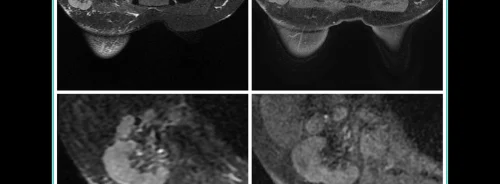Radial scars are mammary lesions characterised by a fibroelastotic core and radiating ducts and lobules. They are primarily detected on mammography, often as architectural distortion, with increasing identification due to digital breast tomosynthesis (DBT). Surgical excision has historically been recommended due to variable upstaging rates, but recent studies show lower but still variable rates. Existing research has limitations, including the predominance of digital mammography, exclusion criteria, and lack of distinction between screening and diagnostic mammography. Further research is needed to determine if certain subsets of radial scars can be safely managed with imaging surveillance instead of surgery. A study recently published in the American Journal of Roentgenology aims to assess the upstaging rates of DBT-detected radial scars with and without atypia and identify associated risk factors.
Upstaging Rates of DBT-Detected Radial Scars with and without Atypia
This retrospective study, conducted under HIPAA guidelines, investigated patients with radial scars identified through core-needle biopsy (CNB) after combined digital breast tomosynthesis (DBT) and digital mammography (DM) screening from 2013 to 2020 at a single academic medical centre. Patients were excluded if they didn't undergo surgical excision or a minimum of 2 years of imaging surveillance post-CNB. The study focused on the upstaging rates of DBT-detected radial scars with and without atypia. Screening mammograms utilised combined DBT and DM, with ultrasound for further evaluation of indeterminate findings. Biopsies were guided by mammography or ultrasound, with surgical consultation post-CNB. Histopathology slides were clinically reviewed, and lesions were classified based on biopsy reports as radial scars with or without associated atypia. Surgical pathology reports were reviewed for cancer presence and characteristics. The study aimed to identify features associated with upstaging risk in radial scars. Initially, 165 women with 171 screening DBT-detected radial scars, with or without atypia, were identified. Among them, 12 women with 12 radial scars didn't undergo surgical excision or at least 2 years of imaging follow-up after CNB and were excluded. The final analysis included 153 women with 159 radial scars, with a mean age of 56 years (range, 33-83 years).
Analysis of Management Strategies for DBT-Detected Radial Scars
In this study, 159 radial scars detected through screening digital breast tomosynthesis (DBT) in 153 women were examined. Among these, eight radial scars were upstaged to either ductal carcinoma in situ (DCIS) or invasive breast cancer, resulting in an overall upstaging rate of 5.0%. Notably, the upstaging rate differed significantly based on the presence of atypia, with radial scars without atypia showing a much lower rate of upstaging (1.6%) compared to those with atypia (20.0%). Furthermore, none of the radial scars presenting as calcifications were upstaged to cancer, suggesting a potentially lower risk associated with this specific presentation. The findings indicate that surveillance may be a reasonable management strategy for radial scars without atypia, particularly when presenting as calcifications. However, the decision between surveillance and surgical excision should consider various factors, including patient age, prior breast cancer diagnosis, and family history of breast cancer, all of which were found to be associated with upstaging risk. Additionally, while there was no significant association between upstaging and the biopsy guidance modality or the number of biopsy samples acquired, it's worth noting that previous literature suggests the reliability of a radial scar diagnosis increases with a higher number of biopsy samples obtained.
Despite providing valuable insights, the study has some limitations, such as its retrospective design, single-centre nature, and lack of assessment of the extent of radial scar removal during biopsy. Nevertheless, these findings contribute to the growing body of evidence supporting surveillance as a viable option for managing radial scars without atypia detected during screening, aligning with BI-RADS recommendations for probable benign lesions.
Source: American Journal of Roentgenology
Image Credit: iStock










